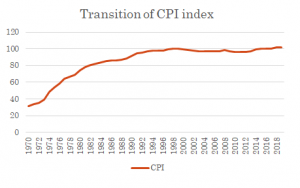Question:
In Japan, the brand new apartments’ rent is the highest and gradually start decreasing and the property gets less marketable. In other major cities in the world, the rental value increases as time passes, reflecting price index. Why has the rental value in Japan always been in declining trend?
Answer : I picked up five more convincing answers.
1 Deflation
2 Economic maturity
3 Functional deterioration
4 Decreasing demography
5 Easy “scrap and build”
1 Deflation

Since the early Heisei bubble collapsed in 1990, Japan has been suffering deflation economy and even though the central bank has launched economic bazooka to boost the economy to create the inflation as well as GDP growth, Japan has been unsuccessful to create them. This has affected to the real estate industry and kept the rental value almost no growth.
2 Matured economy

Japan’s actual GDP has not grown that much since 1990 and got into the matured market.
Under the growing and developing economy, people enjoy the high economic growth and emerging high-net worth social classes contribute to surge the rental value increase as they lead the high-end residential sectors.
Nevertheless, looking at Japan, we haven’t evidenced such phenomena since Heisei bubble in late 80’. People’s salary has not increased that much or rather actual house income has been decreasing and therefore, rental value for the apartment looks hard to surge again.
3 Functional deterioration

This is quite distinct in Japan. In 60’ and 70’, Japan took modernized design and architectural features a lot from Western countries. Even though those features looked very advanced and modern at that time, as time passes, those got old-fashioned or outdated in the market.
For instance, Ark Hills or Hiroo Garden, which have been well preferred apartment as expat-residence in central Tokyo, ceiling height of them look a bit low compared to recently built ones. Therefore, the rent of those apartments get less marketable.
4Aging society & Demographic decrease

In 60’s and 70’ , to fulfill the increasing demography, Japan encouraged a lot urban city developments according to the national master plans. For instance, Tama New Town, located in the west side of greater Tokyo area, had had a large demographic increase till 2002. However, as population turned into stabilized and saturated stage, new entrance to those regional cities started decreasing. Now around 25% of the residents are in their retirement age, no entrance, thus the rental value in such destinations that are exposed to the less population and the aging society, would obviously decrease, unless the area starts accepting foreigners as immigration.
5 Easy “scrap and build” environment

As to the middle size residential apartment in B location in Tokyo, generally speaking, the demolition of the existing facility takes a couple of months. The planning and building permission takes another couple of months. Then new construction takes six months to one year maximum. Every procedure looks so secured, quick and reliable. Therefore, owners tend to choose scrap and build strategy when their property get old and less marketable. As a result, considerable amount of brand new properties are always in the market, making old ones less and less marketable.
Should you have queries doubts, or simply comments , please email to ytomizuka@abrilsjp.com










